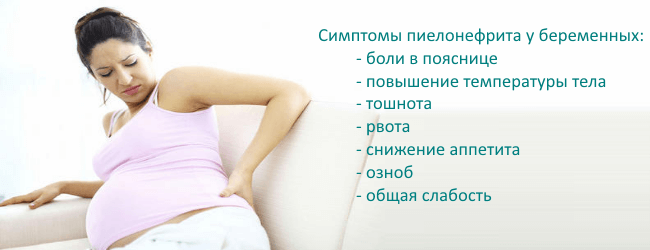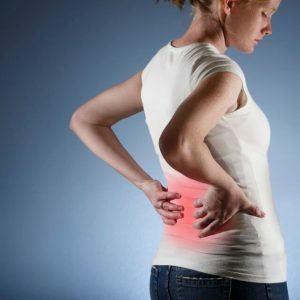Pyelonephritis: symptoms, treatment, features of the course of the disease in pregnant women and children
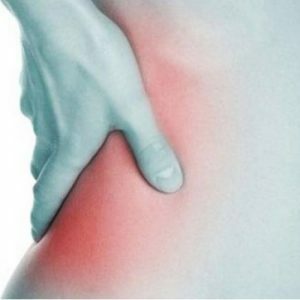 Pyelonephritis is an inflammatory process in the calyx and pelvis and kidney tissues.The disease is most often diagnosed in children under 5 years of age, because during this period in the urine there are almost no antimicrobial agents, and the children can not completely empty the bladder.
Pyelonephritis is an inflammatory process in the calyx and pelvis and kidney tissues.The disease is most often diagnosed in children under 5 years of age, because during this period in the urine there are almost no antimicrobial agents, and the children can not completely empty the bladder.
Classification of pyelonephritis
There are two main forms of consideration of the inflammatory process in the kidneys:
- primary - occurs against a background of normal anatomic structure of the urinary system andAbsence of any diseases that can provoke a stagnation of urine in the kidneys;
- secondary - begins development on the background of pathological changes in the structure of the kidneys, ureters and bladder of an innate character or existing diseases that lead to stagnation of urine in the kidneys( for example, diabetes mellitus, kidney stone disease).Pyelonephritis, in its course, can be diagnosed as:
- Acute pyelonephritis - the inflammatory process develops rapidly and lasts for a relatively short time( less than 6 consecutive months);

- chronic pyelonephritis is an inflammatory process characterized by constantly growing symptoms, stages of remission and exacerbation, and a duration of more than 6 months.
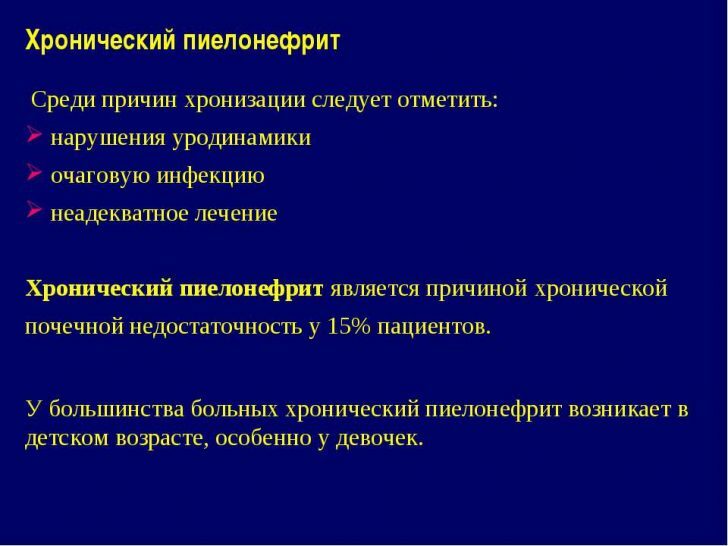
If we consider the localization of the inflammatory process in the kidneys, then it can be one-sided and two-sided.That is, in the case of development of pathology in the left or right kidney( any one), the diagnosis will sound like a one-sided pyelonephritis, in the case of inflammation in both organs - bilateral pyelonephritis.
A more detailed classification and list of possible complications are given below:
Important: , the inflammatory disease in the kidneys under consideration can occur in a lighter form( without complications) and in more severe( with complications).
Causes of pyelonephritis
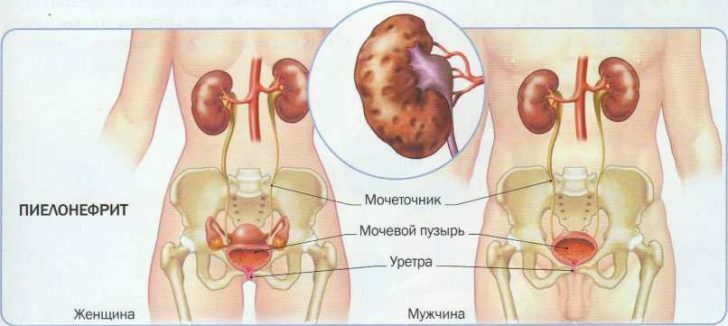
The cause of the development of the inflammatory process in the kidneys is the presence of a pathogenic agent.As a rule, pyelonephritis is caused by staphylococci, streptococci, E. coli, enterococci, viruses and fungi. The spread of the inflammatory process occurs in two ways:
- ascending - is inherent in girls and women when the infection, penetrating through the external genitalia, "moves" deeper and upward, reaching the kidneys;
- hematogenous - pathogenic agents enter the kidneys through the blood and in this case the development of the inflammatory process is possible in the presence of any chronic disease( for example, tonsillitis - inflammation of the palatine tonsils, sinusitis - inflammation of the nasal sinuses).
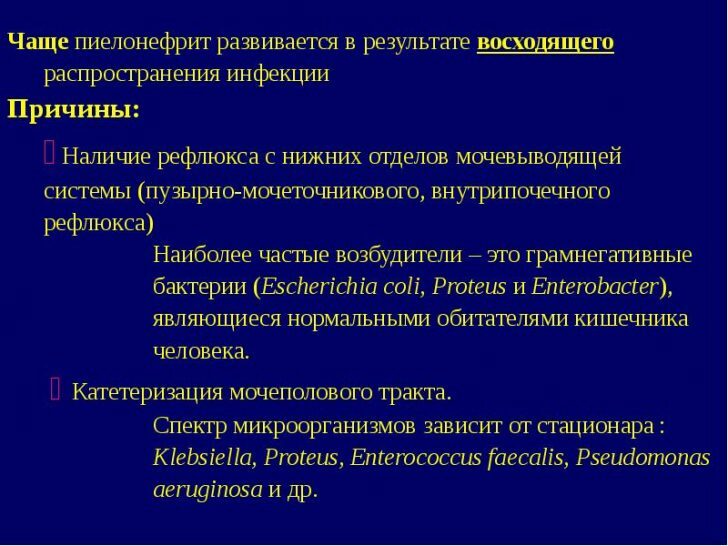
 However, the presence of the above reasons does not always lead to the development of pyelonephritis, because for this there should be also favorable factors:
However, the presence of the above reasons does not always lead to the development of pyelonephritis, because for this there should be also favorable factors:
- acute colds with frequent relapses;
- congenital diseases of the urinary system;
- scarlet fever is a childhood disease, the causative agent of which is streptococcus;
- regular supercooling of the body( for the onset of acute pyelonephritis it is enough to freeze once);
- low level of immunity;
- urolithiasis, but only if the ureter stone overlaps;
- vesicoureteral reflux is a pathology that reverses the flow of urine from the bladder into the calyx and the renal pelvis;
- presence of chronic inflammatory diseases - caries, tonsillitis;
- insufficiently full emptying of the bladder;
- Diabetes.
Symptoms of pyelonephritis
Acute pyelonephritis always begins with a sudden increase in temperature to critical values (39-40 degrees), accompanied by hyperthermia, chills, severe weakness and increased sweating. Other symptoms of pyelonephritis:
- dry mouth and strong thirst;
- a headache of a non-intensive nature;
- decreased appetite, nausea and one-time vomiting;
- frequent urge to urinate - frequent urination;
- in the lumbar region - painful / pulling;
- swelling of individual parts of the face( most often eyelids suffer);
- turbidity of urine.
The above symptoms are characteristic of the acute course of pyelonephritis; in chronic form, not only they are noted, but also
- a steady increase in blood pressure;
- chronic renal failure.
Note: mistakenly assumes that is unequivocally evidence of pyelonephritis - the kidneys are located on either side of the spinal column just below the ribs.
Methods for diagnosis of pyelonephritis
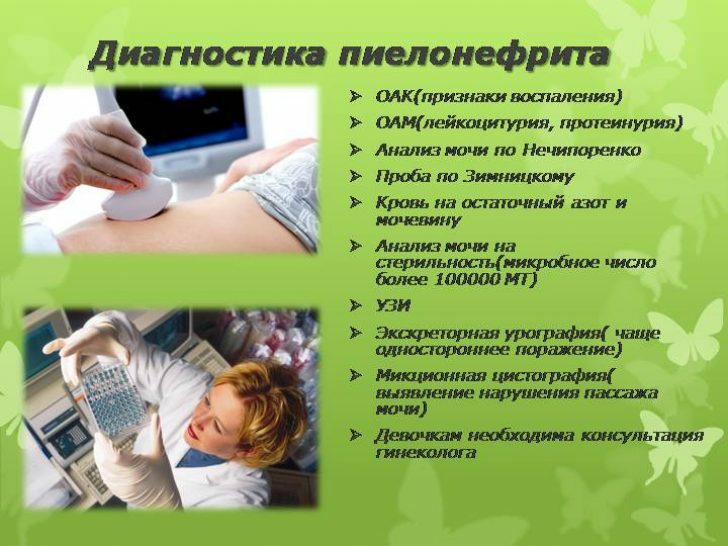
Pyelonephritis is diagnosed very easily - the symptoms of this inflammatory disease are pronounced.But self-diagnosis can not be done - the same symptoms can also indicate other pathologies in the urinary system. Referring to a specialist( kidney and urinary tract diseases is handled by a urologist), the patient undergoes the following diagnostic procedures:
- Doctor's collection of patient complaints: hyperthermia( fever), chills, nausea / vomiting, headache of paroxysmal nature, pain inLow back, frequent urination, and others, characteristic of pyelonephritis;
- Patient examination: assessment of the coloration of the skin( with paleonephritis they are pale), revealing puffiness of the face( this is noticeable on the eyelids), severe pain in palpation( probing) of the kidneys, painful reaction to Pasternatsky syndrome( effleurage to the right and left of the spinal column in the regionAnatomical location of the kidneys).
- Laboratory tests:
- general blood test - an increase in the number of leukocytes, an increase in the rate of erythrocyte sedimentation( ESR);
- biochemical blood test - violation of protein fractions: decreased albumin / increased globulin, increased urea level;
- general analysis of urine - an increased number of white blood cells, a large number of bacteria in the urine, a protein in the urine;
- biochemical analysis of urine - increases the level of urate, oxalate and phosphate;
- urine culture - find out the presence of pathogenic bacteria, most often secrete an E. coli and staphylococcus;
- antibiogram is used to determine which preparation should be treated with pyelonephritis.
- Laboratory tests:
- Nechiporenko test - performed in case of abnormalities in the general urine test.Scheme of the exercise: collect the middle stream of morning urine - the first and last stream is drained, only the middle portion is poured into the vessel.With pyelonephritis, the increased content of proteins, leukocytes and erythrocytes is determined;
- Zimnitsky's test - the doctor determines the concentration ability of urine.Scheme of carrying out: during the day urine is collected every 3 hours in different jars.With pyelonephritis, the concentration capacity of urine( density) will be very low.
- Instrumental examination:
- urography - X-ray examination of the kidneys and urinary tract with the help of a contrast medium, which is injected into the patient's body intravenously;
- radioisotope renography - the principle of research is the ability of the kidneys to accumulate radioisotope particles, which makes it possible to determine the symmetry of the lesion of the paired organ;
- ultrasound - the image will be seen not only foci of inflammation in the kidneys, but also the existing pathological changes in the structure;
- computed tomography - the diagnosis is confirmed, the degree of spread of the inflammatory process and the depth of damage to the kidney tissues are determined.
Principles of treatment of pyelonephritis
Treatment of the inflammatory process in the kidneys can be carried out in two ways: medicamentally and folk methods.It can not be said that any one of the methods will be effective, but some will not - it is desirable to use them in a complex.
Drugs for pyelonephritis
In the case of acute pyelonephritis or with exacerbation of the chronic form of pathology, the doctors make the following prescriptions:
- antibacterial agents( antibiotics) of a wide spectrum of action - cephalosporins, penicillins, macrolides;
- non-steroidal anti-inflammatory drugs;
- preparations that promote the improvement / acceleration of blood circulation in the kidneys;
- vitamins.
Antibiotics in the treatment of pyelonephritis are prescribed by a course lasting no more than 7 days, with subsequent replacement to avoid getting used to a particular kind of remedy.The duration of treatment with antibacterial drugs is 21 days.
Non-steroidal anti-inflammatory drugs are prescribed only 3-5 days after initiation of antibiotic treatment - during the period of acute inflammation.Duration of treatment with these drugs is 10 days.
Diet for pyelonephritis
Pyelonephritis means adherence to a special diet:
- to limit the amount of salt consumed - the allowed maximum is 2-3 grams per day;
- complete rejection of marinades, salted, smoked products;
- abolition of fatty meat and fish;
- use of a large amount of liquid;
- every day on the table should be kefir, cottage cheese and any lactic products.
The use of a large amount of fluid requires the appointment of diuretics( diuretics), otherwise there will be a stagnation of urine in the kidneys, swelling will increase and the inflammatory process will receive favorable factors for further spread.
Surgical treatment of pyelonephritis does not exist, but if this inflammatory process in the kidneys is provoked by a blockage of the ureter with a stone, it is removed by surgery.
Folk methods of treatment of pyelonephritis
Traditional medicine has several dozen recipes that are recommended for use in the treatment of pyelonephritis. But the most effective are:
- Honey and elecampane.It is necessary to grind 100 g of the root of elecampane, mix with 500 ml of honey and take on a tablespoon before each meal for 1 month.Oat and milk.200 grams of oats boil for 15 minutes in a liter of milk, cool and strain.The resulting broth should be taken 50 ml 4 times a day until the symptoms of pyelonephritis disappear completely.
-
 Herbal collection.Take 2 tablespoons of roots of elecampane, chamomile flowers and mother-and-stepmother, licorice root, tansy flowers, peony evading.Mix and pour dry mass with a liter of boiling water, insist for 12 hours( it is better to do this in a thermos and leave to insist on the night).Scheme of application: half a cup three times a day for 30-40 minutes before meals.
Herbal collection.Take 2 tablespoons of roots of elecampane, chamomile flowers and mother-and-stepmother, licorice root, tansy flowers, peony evading.Mix and pour dry mass with a liter of boiling water, insist for 12 hours( it is better to do this in a thermos and leave to insist on the night).Scheme of application: half a cup three times a day for 30-40 minutes before meals.
Pyelonephritis during pregnancy
 During gestation, gestational pyelonephritis most often develops, which causes mechanical pressure on the paired organ.Pressure exerts a growing uterus as the fetus grows, so in 70% of cases the diagnosis of pyelonephritis is present during the gestation of the child.
During gestation, gestational pyelonephritis most often develops, which causes mechanical pressure on the paired organ.Pressure exerts a growing uterus as the fetus grows, so in 70% of cases the diagnosis of pyelonephritis is present during the gestation of the child.
What should I do pregnant with gestational pyelonephritis:
- first, undergo treatment in the hospital;
- second, adhere to a strict diet with the exception of smoked, salty and fatty foods;
- third, increase the amount of fluid used.
If gestational pyelonephritis develops early in pregnancy( in the first trimester), then it does not represent any danger to the fetus and the woman herself.It is enough only to carry out necessary medical measures and strictly observe the recommendations of the attending physician and his gynecologist.In the case of diagnosing this disease in the third trimester of pregnancy, a woman is placed in a medical institution, followed by a permanent control, in some cases antibacterial drugs are indicated.
Important : usually with pyelonephritis during pregnancy, there are no consequences for the fetus: this disease does not lead to complications of pregnancy and does not affect fetal development.In very rare cases, the birth of an infected fetus is noted.
Pyelonephritis in childhood
Inflammatory process in kidneys in children practically does not differ in its symptoms and reasons from pyelonephritis, which occurs in more adult people. What you need to pay attention to parents for timely diagnosis of this disease: 
- a child can drink significantly more fluids, but the amount of urination does not increase;
- with each urination the child shows discontent with crying / whims( if he is very small) or complains of pain and burning( "bake");
- at night the baby is restless, often there are sudden crying - so children react to renal colic;
- appetite is significantly reduced;
- may appear indifferent even to the most enjoyable occupations.
Please note: treatment of pyelonephritis in children takes place solely under the supervision of doctors, there is no question of finding a home and applying folk recipes!
The duration of therapy is at least 3 weeks, then the children undergo a rehabilitation period, to prevent the return of symptoms of pyelonephritis, preventive measures should be taken:
- to avoid hypothermia;
- conduct personal hygiene according to generally accepted rules;
- regular examination of the child by doctors;
- strengthening of immunity by hardening, consumption of vitamins.
Pyelonephritis is not considered a dangerous disease, moreover, even a chronic form of inflammation in the kidneys can be introduced into long-term remission.
Recommended:You will receive more information about the symptoms, methods of diagnosis and treatment of pyelonephritis by viewing this video review:
Tsygankova Yana Aleksandrovna, medical reviewer, therapeutist of the highest qualification category.


